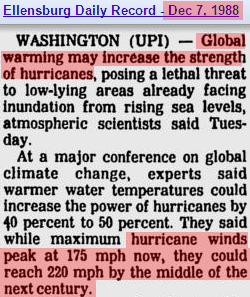After his spectacular post-2005 hurricane forecast failure (10 years of no major US hurricanes) Kerry Emanuel has crawled back out of his hole for a repeat.
in a new study in Nature Climate Change, Princeton’s Ning Lin and MIT’s Kerry Emanuel demonstrate that when it comes to three global cities in particular — Tampa, Fla., Cairns, Australia, and Dubai, United Arab Emirates — there could come a storm that is much worse than anything in recent memory (or in any memory).
This is also the exact same BS they were saying 30 years ago.
America’s most powerful hurricane hit Florida this week in 1935.





Thank you for using your keen analytical mind to identify reality.
Since 1543, reality has been viewed as a threat to hubris leaders of nations and religions:
https://www.researchgate.net/publication/279955675_Introduction_to_SCIENCE_FOR_TEACHERS
After 1945, modern science was misguided by a propaganda artist that united nations and national academies of science worldwide on 24 Oct 1945 to form “Orwellian Ministries of Consensus Science and Politically Correct Thoughts“ – JOSEPH STALIN:
https://www.researchgate.net/publication/281017812_STALIN'S_SCIENCE
The unanswered question: Can society be returned to sanity (contact with reality) without undergoing a crash landing of our economic and social systems?
Since 1543, reality has been viewed as a threat to WESTERN leaders of nations and religions. The concept of reality may have changed abruptly for people of Japan after unconditional surrender at the end of WWII.
http://libertyblitzkrieg.com/2015/08/31/unusually-massive-protests-erupt-in-japan-against-forthcoming-war-legislation/
Australia’s Bureau of Meteorology supports global warming/climate change alarm BUT when it comes to tropical cyclones it does not report ANY trend of increasing severity of cyclones – the complete opposite in fact.
“Tropical cyclones in the Australian region are influenced by a number of factors, and in particular variations in the El Niño – Southern Oscillation. In general, more tropical cyclones cross the coast during La Niña years, and fewer during El Niño years.
Trends in tropical cyclone activity in the Australian region (south of the equator; 90–160°E) show that the total number of cyclones appears to have decreased to the mid 1980s, and remained nearly stable since. The number of severe tropical cyclones (minimum central pressure less than 970 hPa) shows no clear trend over the past 40 years.”
http://www.bom.gov.au/cyclone/climatology/trends.shtml
Let me summarise:-
During the whole of the period of “unprecedented” warming the number of tropical cyclones crossing the Australian coast decreased to the 1980’s and shows no correlation to the recorded warming or CO2 in terms of numbers or severity !
Frequency of intense typhoons (under 900 mb) in the western Pacific have also decreased markedly since the 1970’s and 1980’s. A good case can be made of an INVERSE correlation between severe tropical disturbances and CO2.
Imagine the power of the winds and the tidal surge that could knock a railroad train off the rails onto its side!
Hell it moved the tracks in some places too! https://s.yimg.com/fz/api/res/1.2/K1A2Xk4xAQaov5sMNIgDpQ–/YXBwaWQ9c3JjaGRkO2g9NDU5O3E9OTU7dz02MDA-/http://www.floridamemory.com/fpc/general/n041527.jpg
Granted, these theoretical storms are also highly unlikely to occur — in some cases, they are 1-in-10,000-year events, or even rarer. The researchers refer to these possible storms as “gray swans,” riffing on the concept of a “black swan” event, an unpredictable catastrophe, or highly impactful event. A “gray swan,” by contrast, can indeed be predicted, even if it is extremely rare.
Be afraid, be vewy vewy afraid! (Elmer Fudd)
Yep! More fantasy crap. Right off the bat:
“Ten years ago, Hurricane Katrina topped the list of the worst storms to ever hit the US when it triggered a 28-foot-tall storm surge that swept over New Orleans.”
With that opening sentence the author, “Kelly Dickerson, Tech Insider ” demonstrated that he or she has no business writing on the subject because that statement is dead wrong.
Anyone that knows anything about it knows that the CAT IV that hit Galveston in 1900 was the worst natural disaster in US history as measured by lives lost. And a little research reveals that the most intense Hurricane to have hit US shores was the 1935 CAT V storm that hit the Florida Keys on Labor day having a recorded low of 892 mbar compared to Katrina’s 920 mbar. And compact but very powerful CAT V Andrew had higher winds than Katrina. All things considered even Wikipedia says that Katrina comes out in third place.